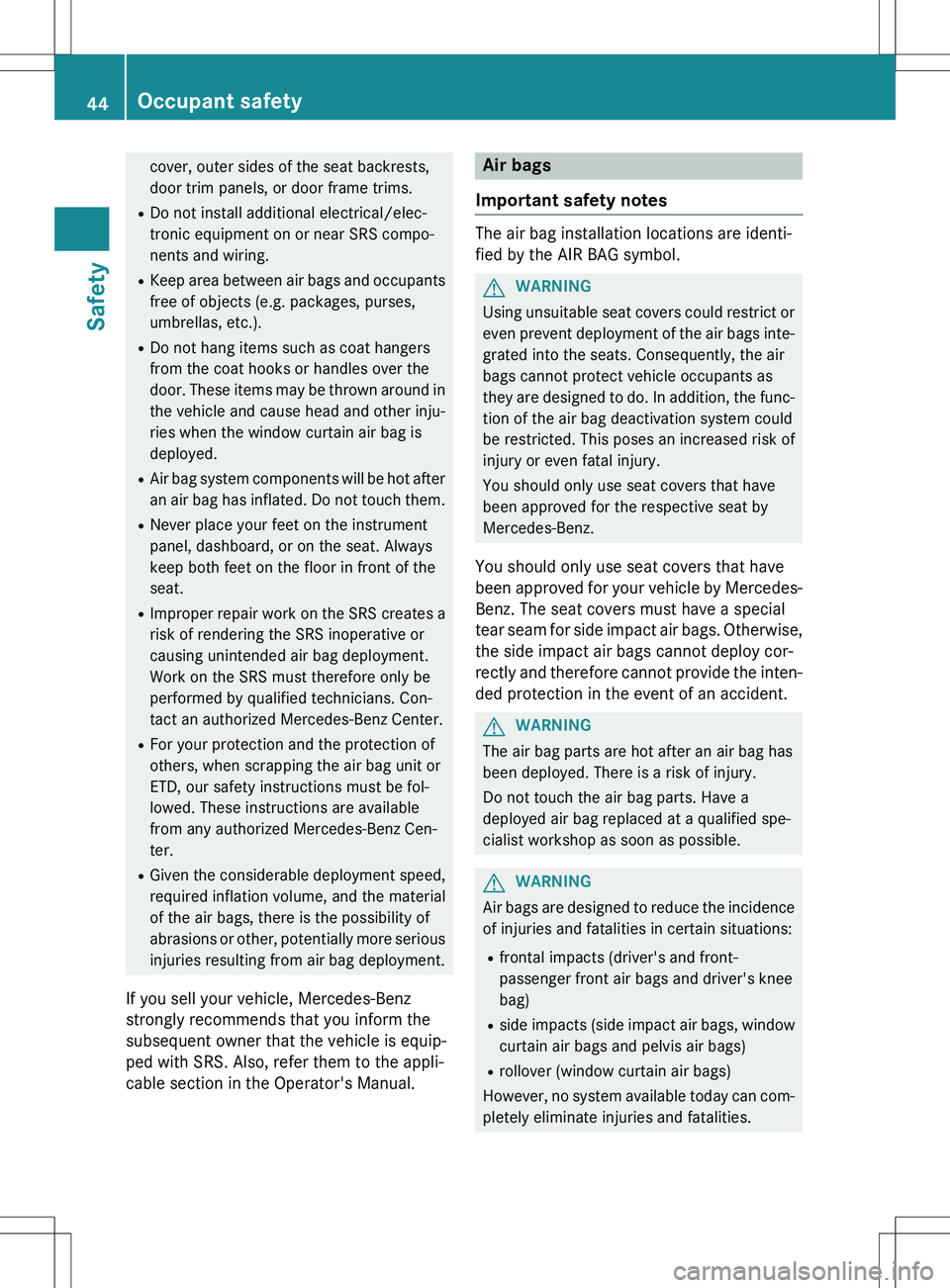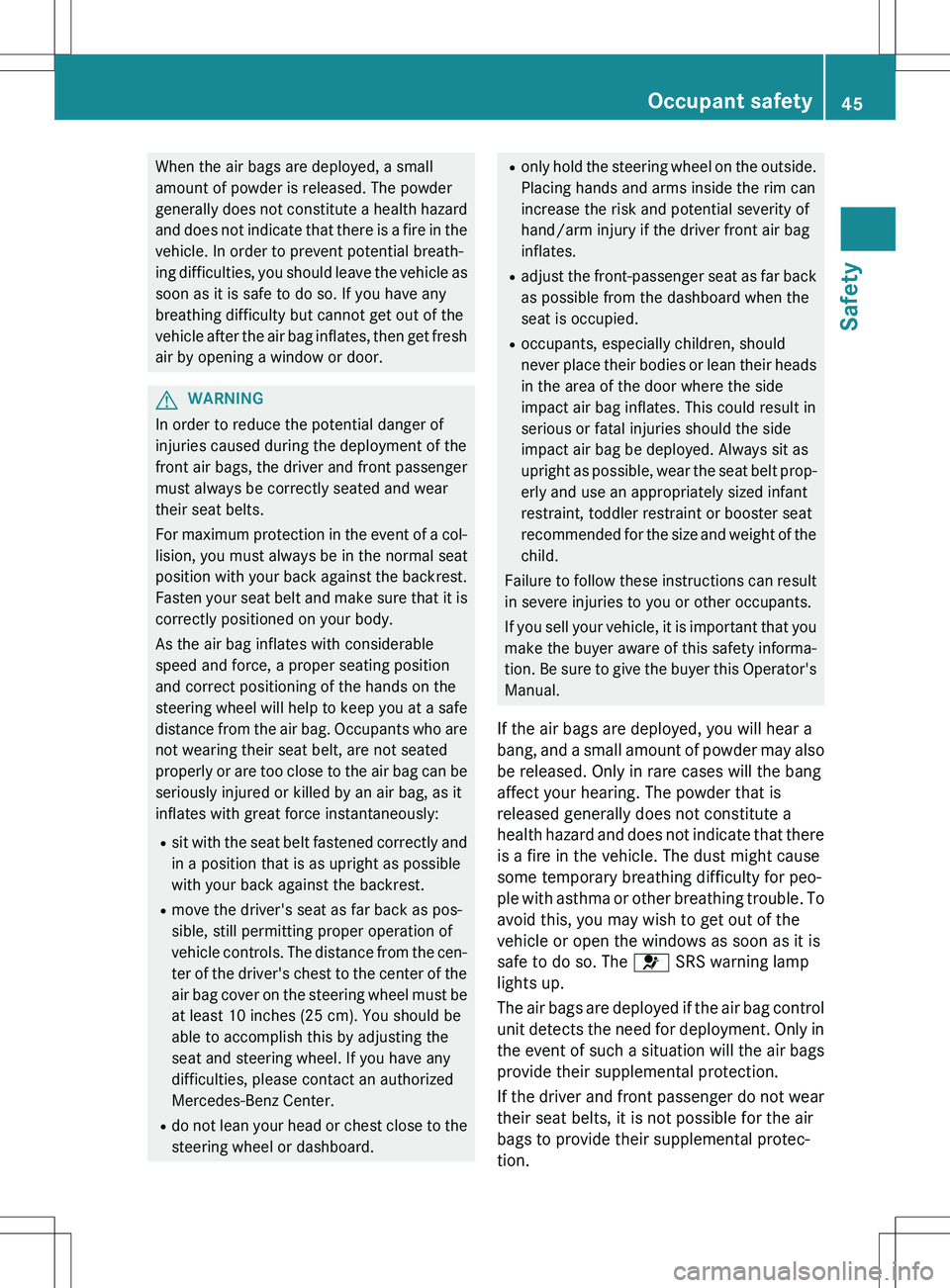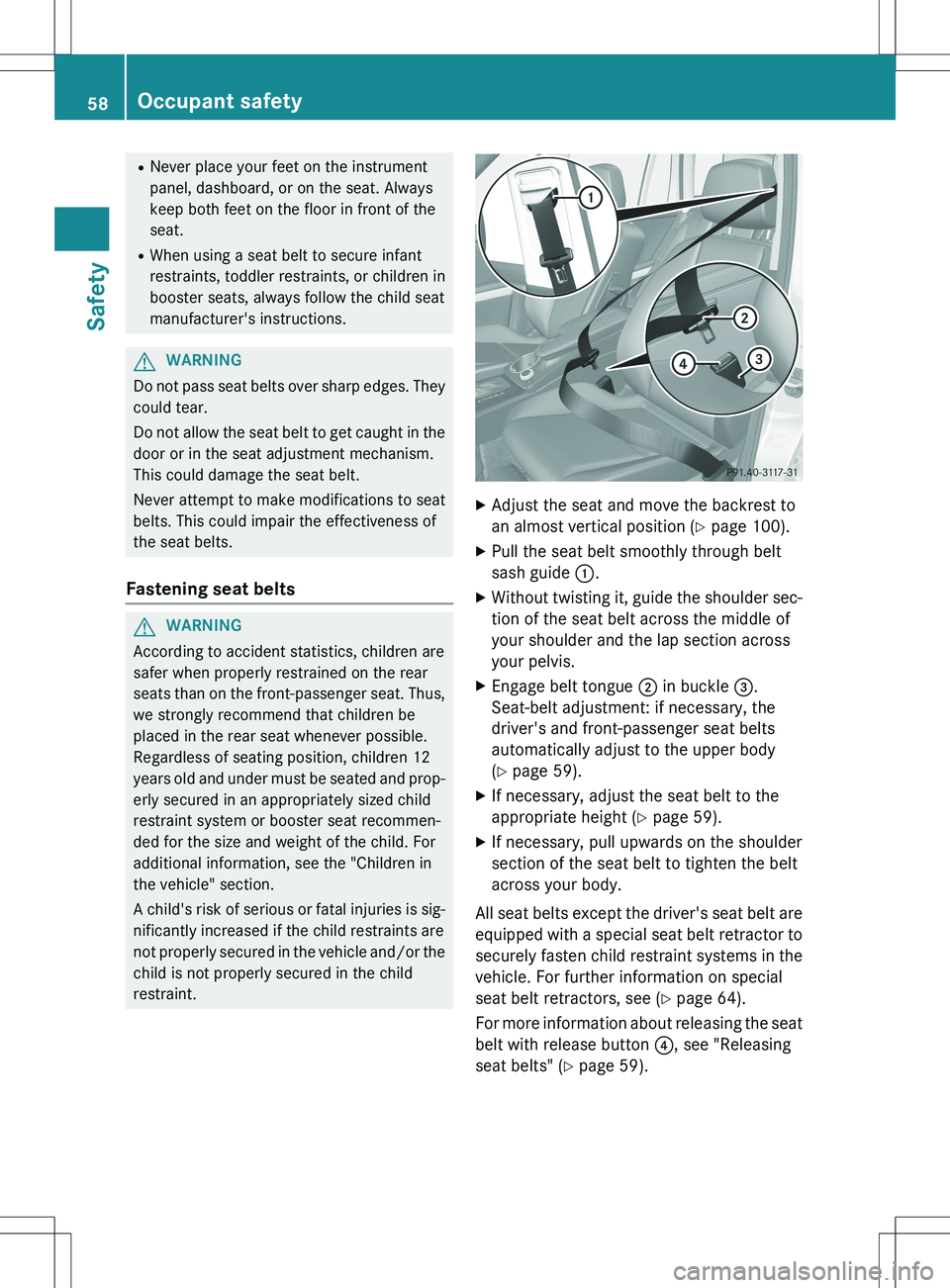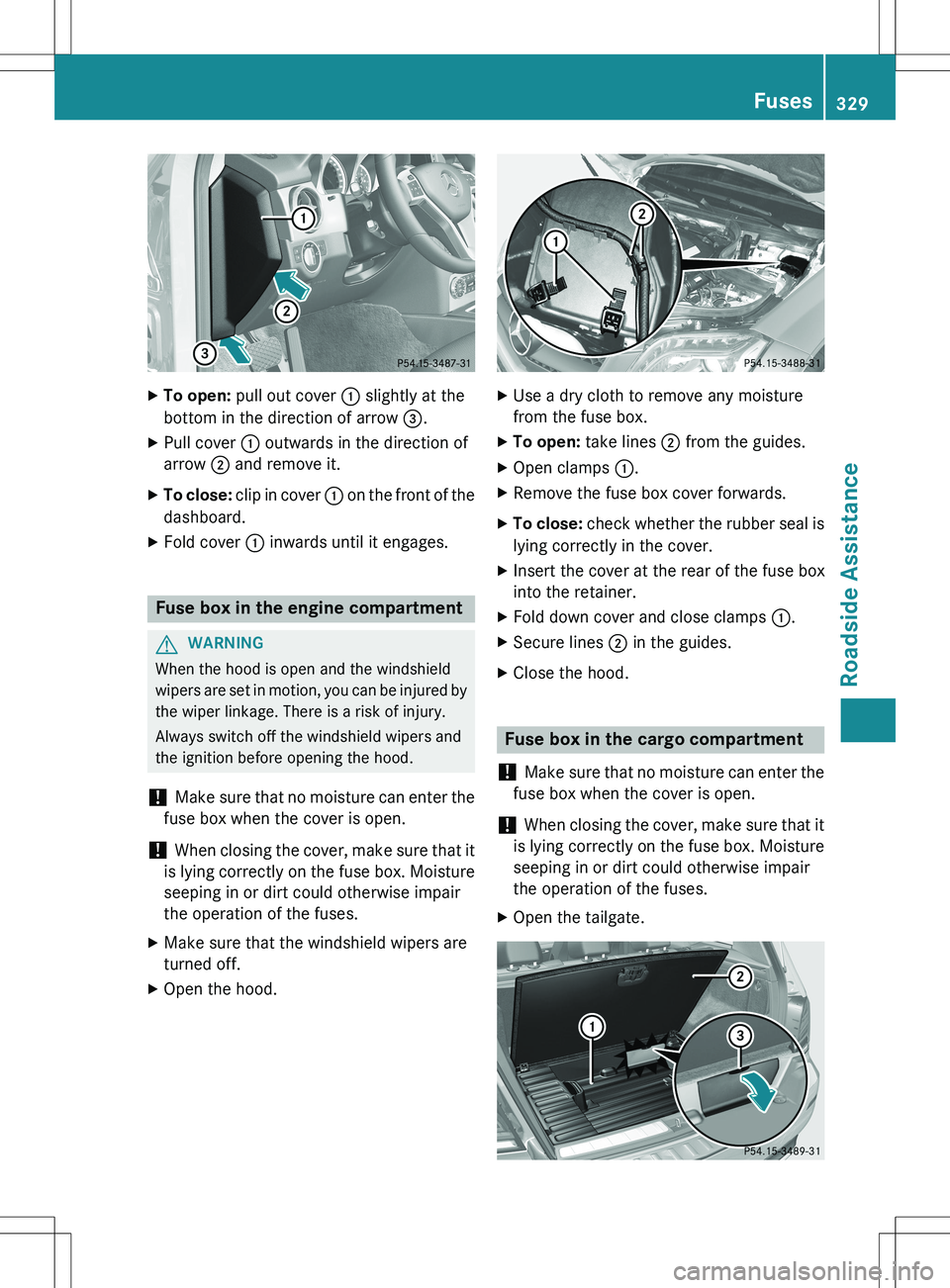2015 MERCEDES-BENZ GLK-CLASS SUV dashboard
[x] Cancel search: dashboardPage 10 of 386

D
Dashboardsee Instrument cluster
Data
see Technical data
Daytime running lamps
Display message ............................ 246
Switching on/off (on-board com-
puter) ............................................. 231
Switching on/off (switch) .............. 116
Declarations of conformity ................. 26
DEF
Adding ........................................... 16 5
Display message ............................ 249
Filling capacity ............................... 376
Important safety notes .................. 376
Delayed switch-off
Exterior lighting (on-board com-
puter) ............................................. 231
Interior lighting .............................. 232
Diagnostics connection ...................... 26
Diesel .................................................. 3 75
Digital speedometer ......................... 224
DIRECT SELECT lever
Automatic transmission ................. 156
Display (cleaning instructions) ........ 310
Display messages
ASSYST PLUS ................................ 304
Calling up (on-board computer) ..... 235
Driving systems ............................. 250
Engine ............................................ 2 46
General notes ................................ 235
Hiding (on-board computer) ........... 235
KEYLESS-GO .................................. 258
Lights ............................................. 24 3
Safety systems .............................. 236
SmartKey ....................................... 258
Tires .............................................. . 255
Vehicle ........................................... 257
Distance recorder ............................. 223
see Odometer
see Trip odometer
Distance warning (warning lamp) .... 270
DISTRONIC PLUS
Activation conditions ..................... 178
Deactivating ................................... 182
Display message ............................ 253 Displays in the multifunction dis-
play ...............................................
. 181
Driving tips .................................... 182
Function/notes ............................. 176
Important safety notes .................. 176
Setting the specified minimum
distance ......................................... 180
Warning lamp ................................. 270
Doors
Automatic locking (on-board com-
puter) ............................................. 232
Automatic locking (switch) ............... 86
Central locking/unlocking
(SmartKey) ....................................... 78
Control panel ................................... 39
Display message ............................ 257
Emergency locking ........................... 86
Emergency unlocking ....................... 86
Important safety notes .................... 84
Opening (from inside) ...................... 84
Drinking and driving ......................... 170
Drive program
Automatic ...................................... 160
Display ........................................... 15 7
Display (DIRECT SELECT lever) ...... 157
Manual ........................................... 160
Driver's door
see Doors
Driving abroad
Mercedes-Benz Service ................. 305
Driving lamps
see Daytime running lamps
Driving safety systems
ABS (Anti-lock Braking System) ....... 68
BAS (Brake Assist System) .............. 69
BAS PLUS (Brake Assist System
PLUS) ............................................... 69
EBD (electronic brake force distri- bution) ............................................ . 73
ESP ®
(Electronic Stability Pro-
gram) .............................................. . 70
ETS/4ETS (Electronic Traction
System) ........................................... 70
Important safety information ........... 68
Overview .......................................... 68
PRE-SAFE ®
Brake ............................. 73
8Index
Page 12 of 386

Engine jump startingsee Jump starting (engine)
Engine oil
Adding ........................................... 30 2
Additives ........................................ 377
Checking the oil level ..................... 301
Checking the oil level using the
dipstick .......................................... 30 1
Display message ............................ 248
Filling capacity ............................... 377
Notes about oil grades ................... 377
Notes on oil level/consumption .... 301
Viscosity ........................................ 377
ESP ®
(Electronic Stability Pro-
gram)
Deactivating/activating ................... 71
Display message ............................ 236
ETS/4ETS ........................................ 70
Function/notes ................................ 70
General notes .................................. 70
Important safety information ........... 71
Trailer stabilization ........................... 72
Warning lamp ................................. 264
ETS/4ETS (Electronic Traction Sys-
tem) ................................................... ... 70
Exhaust check ................................... 170
Exhaust tail pipe (cleaning instruc-
tions) .................................................. 3 09
Exterior lighting
Setting options .............................. 116
see Lights
Exterior mirrors
Adjusting ....................................... 109
Dipping (automatic) ....................... 110
Folding in when locking (on-boardcomputer) ...................................... 233
Folding in/out (automatically) ....... 110
Folding in/out (electrically) ........... 110
Out of position (troubleshooting) ... 110
Setting ........................................... 1 10
Storing settings (memory func-
tion) .............................................. . 112
Storing the parking position .......... 111
F
Filler cap
see Fuel filler flap Flat tire
MOExtended tires .......................... 315
Preparing the vehicle ..................... 314
TIREFIT kit ...................................... 316
see Emergency spare wheel
Floormats ........................................... 298
Fog lamps
Switching on/off ........................... 117
Folding the rear bench seat for-
wards/back ....................................... 276
Fording
On flooded roads ........................... 174
Front fog lamps
Switching on/off ........................... 117
Fuel
Additives ........................................ 375
Consumption statistics .................. 223
Displaying the current consump-
tion ............................................... . 224
Displaying the range ...................... 224
Driving tips .................................... 170
Fuel gauge ....................................... 33
Grade (gasoline) ............................ 374
Important safety notes .................. 373
Premium-grade unleaded gaso-
line ............................................... .. 374
Problem (malfunction) ................... 165
Quality (diesel) ............................... 375
Refueling ........................................ 16 2
Tank content/reserve fuel ............. 374
Fuel filler flap
Opening ......................................... 164
Fuel filter (display message) ............ 249
Fuel level
Calling up the range (on-board
computer) ...................................... 224
Fuel tank
Capacity ........................................ 374
Problem (malfunction) ................... 165
Fuse allocation chart (vehicle tool
kit) ................................................... ... 314
Fuses
Allocation chart ............................. 328
Before changing ............................. 328
Dashboard fuse box ....................... 328
Fuse box in the cargo compart-
ment .............................................. 3 29
10Index
Page 46 of 386

cover, outer sides of the seat backrests,
door trim panels, or door frame trims.
R Do not install additional electrical/elec-
tronic equipment on or near SRS compo-
nents and wiring.
R Keep area between air bags and occupants
free of objects (e.g. packages, purses,
umbrellas, etc.).
R Do not hang items such as coat hangers
from the coat hooks or handles over the
door. These items may be thrown around in
the vehicle and cause head and other inju-
ries when the window curtain air bag is
deployed.
R Air bag system components will be hot after
an air bag has inflated. Do not touch them.
R Never place your feet on the instrument
panel, dashboard, or on the seat. Always
keep both feet on the floor in front of the
seat.
R Improper repair work on the SRS creates a
risk of rendering the SRS inoperative or
causing unintended air bag deployment.
Work on the SRS must therefore only be
performed by qualified technicians. Con-
tact an authorized Mercedes-Benz Center.
R For your protection and the protection of
others, when scrapping the air bag unit or
ETD, our safety instructions must be fol-
lowed. These instructions are available
from any authorized Mercedes-Benz Cen-
ter.
R Given the considerable deployment speed,
required inflation volume, and the material
of the air bags, there is the possibility of
abrasions or other, potentially more seriousinjuries resulting from air bag deployment.
If you sell your vehicle, Mercedes-Benz
strongly recommends that you inform the
subsequent owner that the vehicle is equip-
ped with SRS. Also, refer them to the appli-
cable section in the Operator's Manual.Air bags
Important safety notes
The air bag installation locations are identi-
fied by the AIR BAG symbol.
GWARNING
Using unsuitable seat covers could restrict or even prevent deployment of the air bags inte- grated into the seats. Consequently, the air
bags cannot protect vehicle occupants as
they are designed to do. In addition, the func-
tion of the air bag deactivation system could
be restricted. This poses an increased risk of
injury or even fatal injury.
You should only use seat covers that have
been approved for the respective seat by
Mercedes-Benz.
You should only use seat covers that have
been approved for your vehicle by Mercedes- Benz. The seat covers must have a special
tear seam for side impact air bags. Otherwise,
the side impact air bags cannot deploy cor-
rectly and therefore cannot provide the inten- ded protection in the event of an accident.
GWARNING
The air bag parts are hot after an air bag has
been deployed. There is a risk of injury.
Do not touch the air bag parts. Have a
deployed air bag replaced at a qualified spe-
cialist workshop as soon as possible.
GWARNING
Air bags are designed to reduce the incidenceof injuries and fatalities in certain situations: R frontal impacts (driver's and front-
passenger front air bags and driver's knee
bag)
R side impacts (side impact air bags, window
curtain air bags and pelvis air bags)
R rollover (window curtain air bags)
However, no system available today can com- pletely eliminate injuries and fatalities.
44Occupant safety
Safety
Page 47 of 386

When the air bags are deployed, a small
amount of powder is released. The powder
generally does not constitute a health hazardand does not indicate that there is a fire in the
vehicle. In order to prevent potential breath-
ing difficulties, you should leave the vehicle as soon as it is safe to do so. If you have any
breathing difficulty but cannot get out of the
vehicle after the air bag inflates, then get fresh
air by opening a window or door.
GWARNING
In order to reduce the potential danger of
injuries caused during the deployment of the
front air bags, the driver and front passenger
must always be correctly seated and wear
their seat belts.
For maximum protection in the event of a col- lision, you must always be in the normal seat
position with your back against the backrest.
Fasten your seat belt and make sure that it is
correctly positioned on your body.
As the air bag inflates with considerable
speed and force, a proper seating position
and correct positioning of the hands on the
steering wheel will help to keep you at a safe distance from the air bag. Occupants who are
not wearing their seat belt, are not seated
properly or are too close to the air bag can be seriously injured or killed by an air bag, as it
inflates with great force instantaneously:
R sit with the seat belt fastened correctly and
in a position that is as upright as possible
with your back against the backrest.
R move the driver's seat as far back as pos-
sible, still permitting proper operation of
vehicle controls. The distance from the cen-
ter of the driver's chest to the center of the
air bag cover on the steering wheel must be
at least 10 inches (25 cm). You should be
able to accomplish this by adjusting the
seat and steering wheel. If you have any
difficulties, please contact an authorized
Mercedes-Benz Center.
R do not lean your head or chest close to the
steering wheel or dashboard.
R only hold the steering wheel on the outside.
Placing hands and arms inside the rim can
increase the risk and potential severity of
hand/arm injury if the driver front air bag
inflates.
R adjust the front-passenger seat as far back
as possible from the dashboard when the
seat is occupied.
R occupants, especially children, should
never place their bodies or lean their heads
in the area of the door where the side
impact air bag inflates. This could result in
serious or fatal injuries should the side
impact air bag be deployed. Always sit as
upright as possible, wear the seat belt prop-
erly and use an appropriately sized infant
restraint, toddler restraint or booster seat
recommended for the size and weight of the child.
Failure to follow these instructions can result in severe injuries to you or other occupants.
If you sell your vehicle, it is important that you
make the buyer aware of this safety informa-
tion. Be sure to give the buyer this Operator's
Manual.
If the air bags are deployed, you will hear a
bang, and a small amount of powder may also be released. Only in rare cases will the bang
affect your hearing. The powder that is
released generally does not constitute a
health hazard and does not indicate that thereis a fire in the vehicle. The dust might cause
some temporary breathing difficulty for peo-
ple with asthma or other breathing trouble. To
avoid this, you may wish to get out of the
vehicle or open the windows as soon as it is
safe to do so. The 6 SRS warning lamp
lights up.
The air bags are deployed if the air bag control
unit detects the need for deployment. Only in the event of such a situation will the air bags
provide their supplemental protection.
If the driver and front passenger do not wear their seat belts, it is not possible for the air
bags to provide their supplemental protec-
tion.
Occupant safety45
Safety
Z
Page 60 of 386

RNever place your feet on the instrument
panel, dashboard, or on the seat. Always
keep both feet on the floor in front of the
seat.
R When using a seat belt to secure infant
restraints, toddler restraints, or children in
booster seats, always follow the child seat
manufacturer's instructions.
GWARNING
Do not pass seat belts over sharp edges. They
could tear.
Do not allow the seat belt to get caught in the
door or in the seat adjustment mechanism.
This could damage the seat belt.
Never attempt to make modifications to seat
belts. This could impair the effectiveness of
the seat belts.
Fastening seat belts
GWARNING
According to accident statistics, children are
safer when properly restrained on the rear
seats than on the front-passenger seat. Thus, we strongly recommend that children be
placed in the rear seat whenever possible.
Regardless of seating position, children 12
years old and under must be seated and prop- erly secured in an appropriately sized child
restraint system or booster seat recommen-
ded for the size and weight of the child. For
additional information, see the "Children in
the vehicle" section.
A child's risk of serious or fatal injuries is sig-
nificantly increased if the child restraints are
not properly secured in the vehicle and/or the child is not properly secured in the child
restraint.
X Adjust the seat and move the backrest to
an almost vertical position ( Y page 100).
X Pull the seat belt smoothly through belt
sash guide :.
X Without twisting it, guide the shoulder sec-
tion of the seat belt across the middle of
your shoulder and the lap section across
your pelvis.
X Engage belt tongue ; in buckle =.
Seat-belt adjustment: if necessary, the
driver's and front-passenger seat belts
automatically adjust to the upper body
( Y page 59).
X If necessary, adjust the seat belt to the
appropriate height ( Y page 59).
X If necessary, pull upwards on the shoulder
section of the seat belt to tighten the belt
across your body.
All seat belts except the driver's seat belt are equipped with a special seat belt retractor tosecurely fasten child restraint systems in the
vehicle. For further information on special
seat belt retractors, see ( Y page 64).
For more information about releasing the seat
belt with release button ?, see "Releasing
seat belts" ( Y page 59).
58Occupant safety
Safety
Page 189 of 386

Side view
Top view
Front sensors
CenterApprox. 40 in (approx.
100 cm)
CornersApprox. 24 in (approx.
60 cm)
Rear sensors
CenterApprox. 48 in (approx.
120 cm)
CornersApprox. 32 in (approx.
80 cm)
Minimum distance
CenterApprox. 8 in (approx.
20 cm)
CornersApprox. 6 in (approx.
15 cm)
If there is an obstacle within this range, the
relevant warning displays light up and a warn-ing tone sounds. If the distance falls below
the minimum, the distance may no longer be
shown.
Warning displays
The warning displays show the distance
between the sensors and the obstacle. The
warning display for the front area is located
on the dashboard above the center air vents.
The warning display for the rear area is loca-
ted on the headliner in the rear compartment.
Warning display for the front area :
Segments on the left-hand side of the
vehicle
;Segments on the right-hand side of the
vehicle
=Segments showing operational readiness
The warning display for each side of the vehi-
cle is divided into five yellow and two red seg- ments. PARKTRONIC is operational if yellow
segments showing operational readiness =
light up.
The selected transmission position and the
direction in which the vehicle is rolling deter-
mine which warning display is active when the engine is running.
Driving systems187
Driving and parking
Z
Page 330 of 386

electrical system in the same way as when
jump-starting (Y page 323).
Have the vehicle transported on a transporter or trailer.
Tow-starting (emergency engine
starting)
!
Vehicles with automatic transmission
must not be started by tow-starting. This
could otherwise damage the transmission.
You can find information on "Jump-starting" at
( Y page 323).
Fuses
Important safety notes
GWARNING
If you manipulate or bridge a faulty fuse or if
you replace it with a fuse with a higher amper-
age, the electric cables could be overloaded.
This could result in a fire. There is a risk of an
accident and injury.
Always replace faulty fuses with the specified
new fuses having the correct amperage.
! Only use fuses that have been approved
for Mercedes-Benz vehicles and which
have the correct fuse rating for the system concerned. Otherwise, components or sys-
tems could be damaged.
The fuses in your vehicle serve to close down faulty circuits. If a fuse blows, all the compo- nents on the circuit and their functions stop
operating.
Blown fuses must be replaced with fuses of
the same rating, which you can recognize by
the color and value. The fuse ratings are listedin the fuse allocation chart.
If a newly inserted fuse also blows, have the
cause traced and rectified at a qualified spe-
cialist workshop, e.g. an authorized
Mercedes-Benz Center.
Before changing a fuse
X Secure the vehicle against rolling away
(Y page 168).
X Switch off all electrical consumers.
X Turn the SmartKey to position 0 in the igni-
tion lock and remove it ( Y page 149).
or
X On vehicles with KEYLESS-GO, make sure
the ignition is switched off ( Y page 149).
All indicator lamps in the instrument cluster
must be off.
The fuses are located in various fuse boxes:
R Fuse box on the driver's side of the dash-
board
R Fuse box in the engine compartment on the
left-hand side of the vehicle, when viewed
in the direction of travel
R Fuse box in the stowage well under the
cargo compartment floor on the right-hand
side of the vehicle, when viewed in the
direction of travel
The fuse allocation chart is in the vehicle tool kit which is located in the stowage compart-
ment under the cargo compartment floor
( Y page 314).
Dashboard fuse box
!
Do not use a pointed object such as a
screwdriver to open the cover in the dash-
board. You could damage the dashboard or
the cover.
! Make sure that no moisture can enter the
fuse box when the cover is open.
! When closing the cover, make sure that it
is lying correctly on the fuse box. Moisture seeping in or dirt could otherwise impair
the operation of the fuses.
328Fuses
Roadside Assistance
Page 331 of 386

XTo open: pull out cover : slightly at the
bottom in the direction of arrow =.
X Pull cover : outwards in the direction of
arrow ; and remove it.
X To close: clip in cover : on the front of the
dashboard.
X Fold cover : inwards until it engages.
Fuse box in the engine compartment
GWARNING
When the hood is open and the windshield
wipers are set in motion, you can be injured by
the wiper linkage. There is a risk of injury.
Always switch off the windshield wipers and
the ignition before opening the hood.
! Make sure that no moisture can enter the
fuse box when the cover is open.
! When closing the cover, make sure that it
is lying correctly on the fuse box. Moisture
seeping in or dirt could otherwise impair
the operation of the fuses.
X Make sure that the windshield wipers are
turned off.
X Open the hood.
XUse a dry cloth to remove any moisture
from the fuse box.
X To open: take lines ; from the guides.
X Open clamps :.
X Remove the fuse box cover forwards.
X To close: check whether the rubber seal is
lying correctly in the cover.
X Insert the cover at the rear of the fuse box
into the retainer.
X Fold down cover and close clamps :.
X Secure lines ; in the guides.
X Close the hood.
Fuse box in the cargo compartment
!
Make sure that no moisture can enter the
fuse box when the cover is open.
! When closing the cover, make sure that it
is lying correctly on the fuse box. Moisture seeping in or dirt could otherwise impair
the operation of the fuses.
X Open the tailgate.
Fuses329
Roadside Assistance
Z